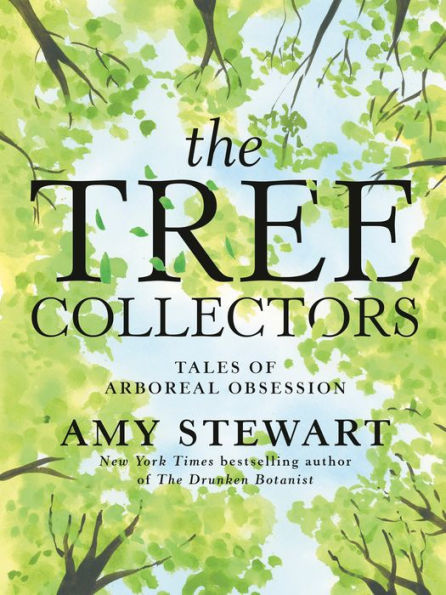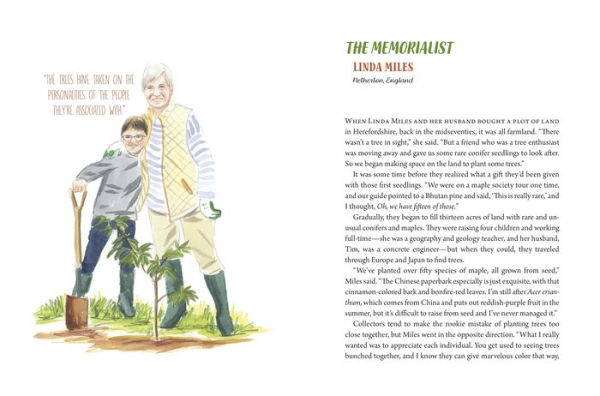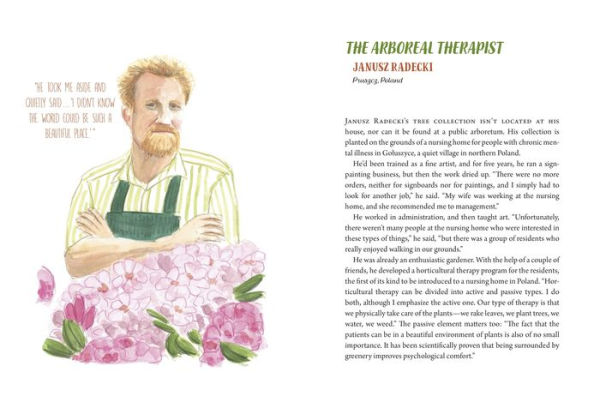The Tree Collectors: Tales of Arboreal Obsession
Fifty vignettes of remarkable people whose lives have been transformed by their obsessive passion for trees—written and charmingly illustrated by the New York Times bestselling author of The Drunken Botanist
“I love everything Amy Stewart has ever created, but this book is my favorite yet. I’m giving this book to everyone I know. Because it, like its subject, is a gift.”—Elizabeth Gilbert, author of Eat Pray Love
When Amy Stewart discovered a community of tree collectors, she expected to meet horticultural fanatics driven to plant every species of oak or maple. But she also discovered that the urge to collect trees springs from something deeper and more profound: a longing for community, a vision for the future, or a path to healing and reconciliation.
In this slyly humorous, informative, often poignant volume, Stewart brings us captivating stories of people who spend their lives in pursuit of rare and wonderful trees and are transformed in the process. Vivian Keh has forged a connection to her Korean elders through her persimmon orchard. The former poet laureate W. S. Merwin planted a tree almost every day for more than three decades, until he had turned a barren estate into a palm sanctuary. And Joe Hamilton cultivates pines on land passed down to him by his once-enslaved great-grandfather, building a legacy for the future.
Stewart populates this lively compendium with her own hand-drawn watercolor portraits of these extraordinary people and their trees, interspersed with side trips to investigate famous tree collections, arboreal glossaries, and even tips for “unauthorized” forestry. This book is a stunning tribute to a devoted group of nature lovers making their lives—and the world—more beautiful, one tree at a time.
"1144003854"
“I love everything Amy Stewart has ever created, but this book is my favorite yet. I’m giving this book to everyone I know. Because it, like its subject, is a gift.”—Elizabeth Gilbert, author of Eat Pray Love
When Amy Stewart discovered a community of tree collectors, she expected to meet horticultural fanatics driven to plant every species of oak or maple. But she also discovered that the urge to collect trees springs from something deeper and more profound: a longing for community, a vision for the future, or a path to healing and reconciliation.
In this slyly humorous, informative, often poignant volume, Stewart brings us captivating stories of people who spend their lives in pursuit of rare and wonderful trees and are transformed in the process. Vivian Keh has forged a connection to her Korean elders through her persimmon orchard. The former poet laureate W. S. Merwin planted a tree almost every day for more than three decades, until he had turned a barren estate into a palm sanctuary. And Joe Hamilton cultivates pines on land passed down to him by his once-enslaved great-grandfather, building a legacy for the future.
Stewart populates this lively compendium with her own hand-drawn watercolor portraits of these extraordinary people and their trees, interspersed with side trips to investigate famous tree collections, arboreal glossaries, and even tips for “unauthorized” forestry. This book is a stunning tribute to a devoted group of nature lovers making their lives—and the world—more beautiful, one tree at a time.
The Tree Collectors: Tales of Arboreal Obsession
Fifty vignettes of remarkable people whose lives have been transformed by their obsessive passion for trees—written and charmingly illustrated by the New York Times bestselling author of The Drunken Botanist
“I love everything Amy Stewart has ever created, but this book is my favorite yet. I’m giving this book to everyone I know. Because it, like its subject, is a gift.”—Elizabeth Gilbert, author of Eat Pray Love
When Amy Stewart discovered a community of tree collectors, she expected to meet horticultural fanatics driven to plant every species of oak or maple. But she also discovered that the urge to collect trees springs from something deeper and more profound: a longing for community, a vision for the future, or a path to healing and reconciliation.
In this slyly humorous, informative, often poignant volume, Stewart brings us captivating stories of people who spend their lives in pursuit of rare and wonderful trees and are transformed in the process. Vivian Keh has forged a connection to her Korean elders through her persimmon orchard. The former poet laureate W. S. Merwin planted a tree almost every day for more than three decades, until he had turned a barren estate into a palm sanctuary. And Joe Hamilton cultivates pines on land passed down to him by his once-enslaved great-grandfather, building a legacy for the future.
Stewart populates this lively compendium with her own hand-drawn watercolor portraits of these extraordinary people and their trees, interspersed with side trips to investigate famous tree collections, arboreal glossaries, and even tips for “unauthorized” forestry. This book is a stunning tribute to a devoted group of nature lovers making their lives—and the world—more beautiful, one tree at a time.
“I love everything Amy Stewart has ever created, but this book is my favorite yet. I’m giving this book to everyone I know. Because it, like its subject, is a gift.”—Elizabeth Gilbert, author of Eat Pray Love
When Amy Stewart discovered a community of tree collectors, she expected to meet horticultural fanatics driven to plant every species of oak or maple. But she also discovered that the urge to collect trees springs from something deeper and more profound: a longing for community, a vision for the future, or a path to healing and reconciliation.
In this slyly humorous, informative, often poignant volume, Stewart brings us captivating stories of people who spend their lives in pursuit of rare and wonderful trees and are transformed in the process. Vivian Keh has forged a connection to her Korean elders through her persimmon orchard. The former poet laureate W. S. Merwin planted a tree almost every day for more than three decades, until he had turned a barren estate into a palm sanctuary. And Joe Hamilton cultivates pines on land passed down to him by his once-enslaved great-grandfather, building a legacy for the future.
Stewart populates this lively compendium with her own hand-drawn watercolor portraits of these extraordinary people and their trees, interspersed with side trips to investigate famous tree collections, arboreal glossaries, and even tips for “unauthorized” forestry. This book is a stunning tribute to a devoted group of nature lovers making their lives—and the world—more beautiful, one tree at a time.
32.0
In Stock
5
1

The Tree Collectors: Tales of Arboreal Obsession
336
The Tree Collectors: Tales of Arboreal Obsession
336
32.0
In Stock

Product Details
| ISBN-13: | 9780593446850 |
|---|---|
| Publisher: | Random House Publishing Group |
| Publication date: | 07/16/2024 |
| Pages: | 336 |
| Sales rank: | 56,221 |
| Product dimensions: | 6.40(w) x 8.40(h) x 1.30(d) |
About the Author
From the B&N Reads Blog







